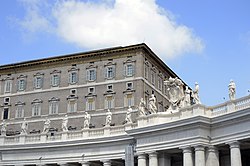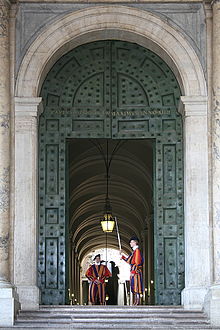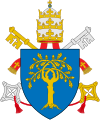
The Sistine Chapel is a chapel in the Apostolic Palace, the pope's official residence in Vatican City. Originally known as the Cappella Magna, the chapel takes its name from Pope Sixtus IV, who had it built between 1473 and 1481. Since that time, the chapel has served as a place of both religious and functionary papal activity. Today, it is the site of the papal conclave, the process by which a new pope is selected. The fame of the Sistine Chapel lies mainly in the frescoes that decorate the interior, most particularly the Sistine Chapel ceiling and The Last Judgment, both by Michelangelo.

The Vatican Museums are the public museums of Vatican City. They display works from the immense collection amassed by the Catholic Church and the papacy throughout the centuries, including several of the most well-known Roman sculptures and most important masterpieces of Renaissance art in the world. The museums contain roughly 70,000 works, of which 20,000 are on display, and currently employ 640 people who work in 40 different administrative, scholarly, and restoration departments.

Pinturicchio, or Pintoricchio, also known as Benetto di Biagio or Sordicchio, was an Italian painter during the Renaissance. He acquired his nickname because of his small stature and he used it to sign some of his artworks that were created during the fifteenth and sixteenth centuries.

Antonio da Sangallo the Younger, also known as Antonio Cordiani, was an Italian architect active during the Renaissance, mainly in Rome and the Papal States. One of his most popular projects that he worked on designing is St. Peter’s basilica in the Vatican City. He was also an engineer who worked on restoring several buildings. His success was greatly due to his contracts with renowned artists during his time. Sangallo died in Terni, Italy, and was buried in St. Peter’s Basilica.

The Lateran Palace, formally the Apostolic Palace of the Lateran, is an ancient palace of the Roman Empire and later the main papal residence in southeast Rome.
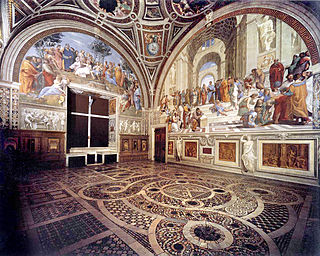
The four Raphael Rooms form a suite of reception rooms in the Apostolic Palace, now part of the Vatican Museums, in Vatican City. They are famous for their frescoes, painted by Raphael and his workshop. Together with Michelangelo's Sistine Chapel ceiling frescoes, they are the grand fresco sequences that mark the High Renaissance in Rome.

The Parish Basilica of Santa Maria del Popolo is a titular church and a minor basilica in Rome run by the Augustinian order. It stands on the north side of Piazza del Popolo, one of the most famous squares in the city. The church is hemmed in between the Pincian Hill and Porta del Popolo, one of the gates in the Aurelian Wall as well as the starting point of Via Flaminia, the most important route from the north. Its location made the basilica the first church for the majority of travellers entering the city. The church contains works by several famous artists, such as Raphael, Gian Lorenzo Bernini, Caravaggio, Alessandro Algardi, Pinturicchio, Andrea Bregno, Guillaume de Marcillat and Donato Bramante.
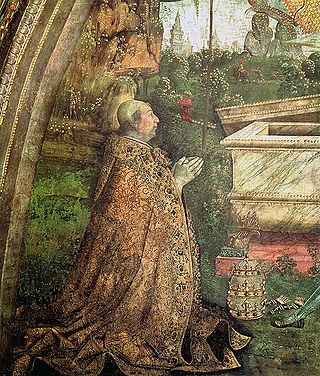
The Borgia Apartments are a suite of rooms in the Apostolic Palace in the Vatican, adapted for personal use by Pope Alexander VI. In the late 15th century, he commissioned the Italian painter Bernardino di Betto (Pinturicchio) and his studio to decorate them with frescoes.
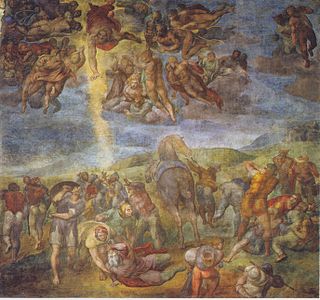
The Cappella Paolina is a chapel in the Apostolic Palace, Vatican City. It is separated from the Sistine Chapel by the Sala Regia. It is not on any of the regular tourist itineraries.

The Disputation of the Sacrament, or Disputa, is a painting by the Italian Renaissance artist Raphael. It was painted between 1509 and 1510 as the first part of Raphael's commission to decorate with frescoes the rooms that are now known as the Stanze di Raffaello, in the Apostolic Palace in the Vatican. At the time, this room was known as the Stanza della Segnatura, and was the private papal library where the supreme papal tribunal met.

The Liberation of Saint Peter is a fresco painting by the Italian High Renaissance artist Raphael. It was painted in 1514 as part of Raphael's commission to decorate with frescoes the rooms that are now known as the Stanze di Raffaello, in the Apostolic Palace in the Vatican. It is located in the Stanza di Eliodoro, which is named after The Expulsion of Heliodorus from the Temple. The painting shows how Saint Peter was liberated from Herod's prison by an angel, as described in Acts 12. It is technically an overdoor.

The Fire in the Borgo is a painting created by the workshop of the Italian Renaissance artist Raphael between 1514 and 1517. Though it is assumed that Raphael did make the designs for the complex composition, the fresco was most likely painted by his assistant Giulio Romano. The painting was part of Raphael's commission to decorate the rooms that are now known as the Stanze di Raffaello, in the Apostolic Palace in the Vatican. It depicts Pope Leo IV halting a fire in 847 with a benediction from a balcony in front of the Old St. Peter's Basilica. The mural lends its name to the Stanza dell'incendio del Borgo.
Various perils are represented in this work. In one part we see a number of women whose hair and clothes are blown about by the terrible fury of the wind as carrying vessels full of water on their heads and in their hands they hurry to put out the fire. There are others bewildered and blinded by the smoke as they try to throw water on the flames. On the other side is depicted an infirm old man, distraught by his weakness and the flames of the fire, being carried by a young man whose face expresses his strength and courage and whose body shows the strain of carrying the figure slumped on his back. He is followed by a dishevelled, bare-footed old woman fleeing from the fire, and going before them is a naked child.

The Sala Regia is a state hall in the Apostolic Palace in Vatican City.
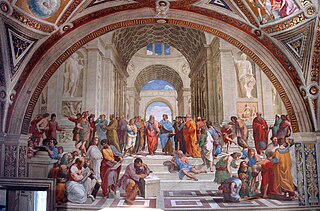
Pope Julius II, commissioned a series of highly influential art and architecture projects in the Vatican. The painting of the Sistine Chapel ceiling by Michelangelo and of various rooms by Raphael in the Apostolic Palace are considered among the masterworks that mark the High Renaissance in Rome. His decision to rebuild St Peter's led to the construction of the present basilica.

The Meeting of Leo I and Attila is a fresco by the Italian Renaissance artist Raphael. It was painted from 1513 to 1514 as part of Raphael's commission to decorate the rooms that are now known as the Stanze di Raffaello, in the Apostolic Palace in the Vatican. It is located in the Stanza di Eliodoro, which is named after The Expulsion of Heliodorus from the Temple.

The Donation of Constantine or Donation of Rome is a painting by assistants of the Italian renaissance artist Raphael. It was most likely painted by Gianfrancesco Penni or Giulio Romano, somewhere between 1520 and 1524. After the master's death in 1520, they worked together with other members of Raphael's workshop to finish the commission to decorate with frescoes the rooms that are now known as the Stanze di Raffaello, in the Apostolic Palace in the Vatican. The Donation of Constantine is located in the Sala di Costantino. It was inspired by the famous forged documents that supposedly granted the Popes sovereignty over Rome's territorial dominions.
This is an index of Vatican City–related topics.

The Cardinal and Theological Virtues is a lunette fresco by Raphael found on the south wall of the Stanza della Segnatura in the Apostolic Palace of the Vatican. Three of the cardinal virtues are personified as statuesque women seated in a bucolic landscape, and the theological virtues are depicted by putti.

The Renaissance in Rome occupied a period from the mid-15th to the mid-16th centuries, a period which spawned such masters as Michelangelo and Raphael, who left an indelible mark on Western figurative art. The city had been a magnet for artists wishing to study its classical ruins since the early 15th century. A revived interest in the Classics brought about the first archaeological study of Roman remains by the architect Filippo Brunelleschi and the sculptor Donatello. This inspired a corresponding classicism in painting and sculpture, which manifested itself in the paintings of Masaccio and Uccello. Pisanello and his assistants also frequently took inspiration from ancient remains, but their approach was essentially cataloguing, acquiring a repertoire of models to be exploited later.

The Hall of the Saints or the Sala dei Santi is a room in the Borgia Apartment of the Vatican Palace, frescoed by the Italian Renaissance artist, Pinturicchio. It dates to 1491–1494 and was commissioned by Pope Alexander VI. The frescoes depict scenes from the lives of the saints. The ceiling fresco, which depicts myths related to the ancient Egyptian gods Osiris and Isis, has been the subject of much scholarly attention. The iconographic program reflects the humanistic interests of Alexander and was likely designed by his secretary, Giovanni Annio of Viterbo.
